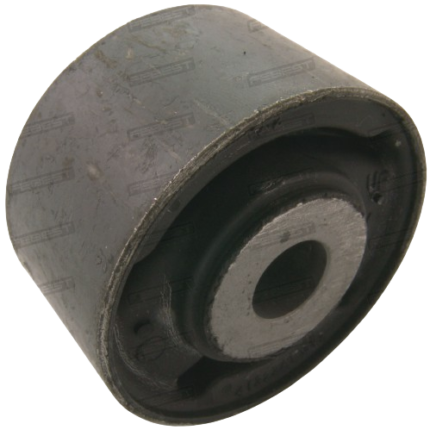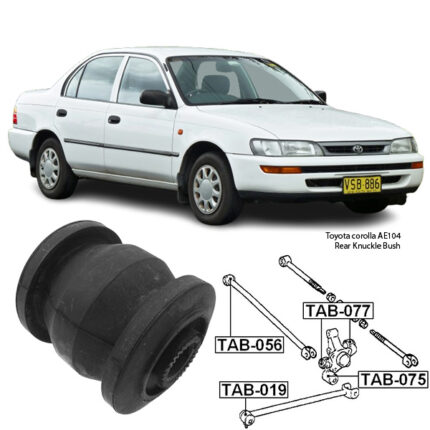-13%
Get Subaru Outback / Legacy Front Stabilizer Bush
The stabilizer bush, also known as the sway bar bushing or anti-roll bar bushing, is a critical component in a vehicle’s suspension system designed to reduce body roll and enhance stability during cornering. It plays a pivotal role in connecting the stabilizer bar (or sway bar) to the vehicle’s chassis or subframe, allowing it to function effectively in controlling lateral movement and maintaining optimal tire contact with the road surface. Here’s an in-depth exploration of the stabilizer bush, covering its functions, importance, signs of wear or failure, and maintenance considerations.
Functions of Stabilizer Bush
- Reducing Body Roll: The primary function of the stabilizer bush is to reduce body roll or sway during cornering and sudden maneuvers. The stabilizer bar connects the left and right wheels of the suspension, and when the vehicle turns, the bar twists to resist the vehicle’s tendency to lean excessively. The stabilizer bushing holds the stabilizer bar in place and allows it to pivot, enabling it to effectively counteract body roll and improve vehicle stability.
- Enhancing Stability and Handling: By reducing body roll, the stabilizer bush contributes to improved vehicle stability and enhanced handling characteristics. It helps maintain even weight distribution across all wheels, minimizing understeer or oversteer tendencies and ensuring predictable and responsive handling.
- Absorbing Noise and Vibrations: Stabilizer bushes are designed to absorb and dampen vibrations and noise generated from the road surface and transmitted through the stabilizer bar. The rubber or polyurethane material of the bushing acts as a cushion, reducing the harshness felt by occupants inside the vehicle and contributing to a smoother and quieter ride.
- Maintaining Suspension Geometry: A properly functioning stabilizer bush helps maintain the correct alignment and geometry of the suspension system. It keeps the stabilizer bar securely attached to the vehicle’s chassis or subframe, preventing excessive movement or misalignment. This alignment stability is essential for ensuring consistent handling, steering response, and tire wear.
Importance of Stabilizer Bush
The stabilizer bush is crucial for several reasons:
- Safety: It improves vehicle stability and control during sudden maneuvers, reducing the risk of rollovers or loss of control.
- Comfort: By reducing body roll and minimizing vibrations, the bushing enhances ride comfort for vehicle occupants, especially during cornering or on uneven road surfaces.
- Performance: Properly functioning stabilizer bushes optimize suspension performance, allowing for better handling, improved steering response, and enhanced overall vehicle dynamics.
Signs of Worn or Failing Stabilizer Bush
- Increased Body Roll: Worn stabilizer bushes can lead to increased body roll during cornering or sudden maneuvers. This occurs because the bushing may no longer provide sufficient support to the stabilizer bar, allowing excessive movement that compromises vehicle stability.
- Clunking or Rattling Noise: As stabilizer bushes wear out, they may develop play or looseness, causing the stabilizer bar to move excessively. This can result in clunking, rattling, or knocking noises from the front or rear suspension when driving over bumps or uneven road surfaces.
- Steering Issues: A failing stabilizer bush can affect steering response and precision. You may notice increased steering effort, a loose or vague feeling in the steering wheel, or difficulty maintaining straight-line stability, particularly at higher speeds.
- Uneven Tire Wear: Misalignment caused by worn stabilizer bushes can lead to uneven tire wear patterns, typically seen as excessive wear on the inner or outer edges of the tires. This not only shortens tire lifespan but also affects vehicle handling and fuel efficiency.
- Visible Damage: During routine inspections, check the stabilizer bushes for signs of wear, cracking, tearing, or deformation. Any visible damage indicates that the bushes are compromised and should be replaced promptly to prevent further issues.
Maintenance and Replacement
- Regular Inspection: Include stabilizer bushes in routine maintenance checks, especially during suspension inspections or when experiencing symptoms of wear or failure. Early detection of worn bushes allows for timely replacement and prevents potential damage to other suspension components.
- Timely Replacement: Replace worn or damaged stabilizer bushes promptly to restore suspension performance and prevent further deterioration. Use high-quality OEM or aftermarket bushes designed for your vehicle’s specific make and model to ensure proper fitment and longevity.
- Professional Installation: Consider having a qualified mechanic or automotive technician perform the bushing replacement, especially if it requires specialized tools or equipment. Proper installation ensures that the bushes are correctly positioned and secured, maintaining the integrity of the suspension system.
- Alignment Check: After replacing the stabilizer bushes, perform a wheel alignment to ensure proper suspension geometry. This step optimizes vehicle handling, tire wear, and steering response, ensuring a safe and comfortable driving experience.
Follow us on Facebook for more parts.





